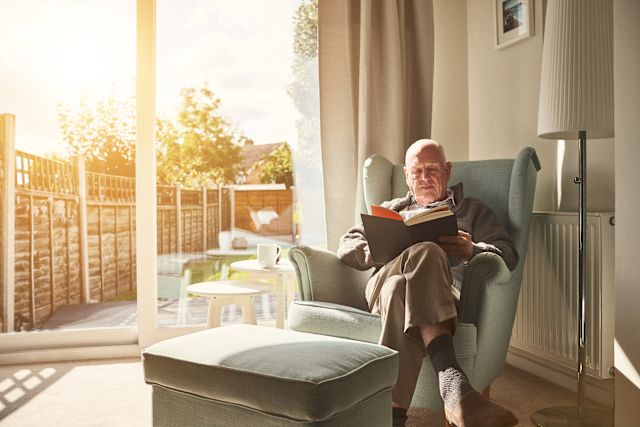Updated on October 21, 2024.
If you’ve ever struggled to make out the print of a magazine in the murk of your living room after dusk, fumbled to line up the prongs of an electrical cord when plugging in a device, or squinted into the dark depths of a cupboard, you could probably use better lighting in your home. In fact, research shows that pretty much anyone can benefit from better lighting.
In fact, lighting levels in the home can affect both health and overall well-being, for good and ill. That’s the takeaway from a large systematic review of 28 studies published in 2021 in the International Journal of Environmental Research and Public Health. Here’s what you need to know about natural light, artificial light, and nighttime lighting in your home and how they may be affecting your health.
Let the sunshine in
Having exposure to natural light in the home has multiple health benefits. These include:
Better physical health
Sunlight exposure in a household is linked to occupants being less likely to be diagnosed with certain infectious diseases. This may be because ultraviolet light helps disinfect the space, even when the light is indirect or when it comes through windows.
Improved mental health
The likelihood of feeling depressed is lower if there’s ample natural daytime illumination in the home, according to research.
Help for sleep hygiene
Though it may seem counterintuitive, there is also evidence that morning illumination enhances sleep quality and length. That means if you use blackout curtains to shield your bedroom from ambient nighttime light, be sure to open them first thing in the morning. Missing out on natural light upon waking may hamper sleep overall.
Sunlight isn’t only beneficial in the home. Having less sunlight exposure in workplaces or in hospitals can also negatively affect people’s sleep quality at night, as well as their mood.
Artificial light can be beneficial, too
The 2021 review also found strong evidence that some kinds of artificial daytime light in the home have positive effects on health. These include:
Improved quality of life
The more lighting in a living space, the better, according to the research. For example, when adults with low vision added a single floor lamp to their living room, this simple change was linked to an improvement in their overall health and mood.
Avoiding accidents
Not surprisingly, inadequate household lighting raises the risk for injuries at home, especially burns and falls. Better illumination lowers the chances of tripping.
The color temperature matters
Color temperature describes how warm or cool a person perceives an artificial light to be. Warmer colors (such as those from traditional incandescent light bulbs) tend to be yellow or orange. Cooler colors tend toward the blue side of the spectrum and approximate natural sunlight.
Cool, blue lights were associated with lower anxiety during the daytime than warmer, yellow lights. The opposite seems to be true at night.
Better sleep health
When it comes to fostering sleep, exposure to cooler, blue light temperatures at night is linked to lower quality sleep and less sleep overall. This may be due to the body sensing the similarities that blue light has to daylight. When the body is exposed to blue light at night, it has the effect of waking the body up. Blue light can also affect circadian rhythms (your internal body clock) because it lowers the production of melatonin, the hormone made by the brain to help you sleep at night.
That’s why experts recommending limiting the use of electronic devices at night because they emit blue light. Instead, power down you devices and illuminate your space with low levels of yellow light from incandescent bulbs.
Be wary of lighting at night
Many of the studies examined by the review found that consistently being exposed to light at night may be harmful to health. This is because it can disrupt circadian rhythm, affecting sleep and other metabolic processes.
Regularly having lights on during sleep was linked to a higher risk of many kinds of health issues, including:
- Breast cancer
- Narrowing of the arteries
- High cholesterol
- Abdominal obesity
- Higher blood pressure
- Depression
- Increased incidences of sleep apnea during the night
Healthy lighting tips
To maximize the benefits of lighting and reduce its potential downsides, follow these tips:
Turn up the lights during waking hours
Wherever possible, increase the amount of both natural and artificial lighting throughout your home and workspace. Turn up existing lighting and add lamps or other lighting to any dim areas, including hallways and stairwells.
Arrange for warmer-toned lights in the evenings
Set up your post-sunset lighting to be full of warm, yellow-toned light, rather than blue-toned light, which mimics sunlight.
Aim for darkness while sleeping
If there are outdoor lights entering through a window while you sleep, try hanging light-blocking curtains.
Try to get morning light
That said, if you have blackout curtains in your bedroom, be sure to open them in the morning. If someone in your home regularly gets up before you, ask them to open your curtains so that you can benefit from a burst of natural morning light.
Protect your eyes
Use focused task lights for specific jobs like reading, sewing, or doing jigsaw puzzles. Light for older adults should be turned up by about 50 percent compared to what younger people might need.
For optimal eye health, get regular eye exams. The American Academy of Ophthalmology recommends that adults with no signs or risk factors for eye disease should get a thorough eye exam with an ophthalmologist (a medical doctor specially trained to treat vision issues) by at least age 40. They should follow up with eye exams every two to four years until age 54 and then every one to three years until age 64. Adults age 65 and older should have an eye exam every one to two years.
See an ophthalmologist right away if you notice any changes in your vision, such as having trouble reading fine print or needing more light than usual to see around the house.







